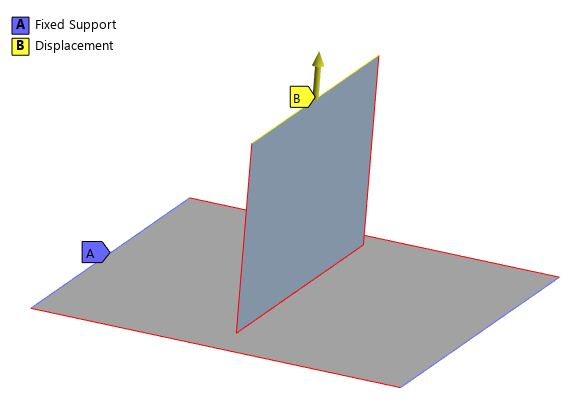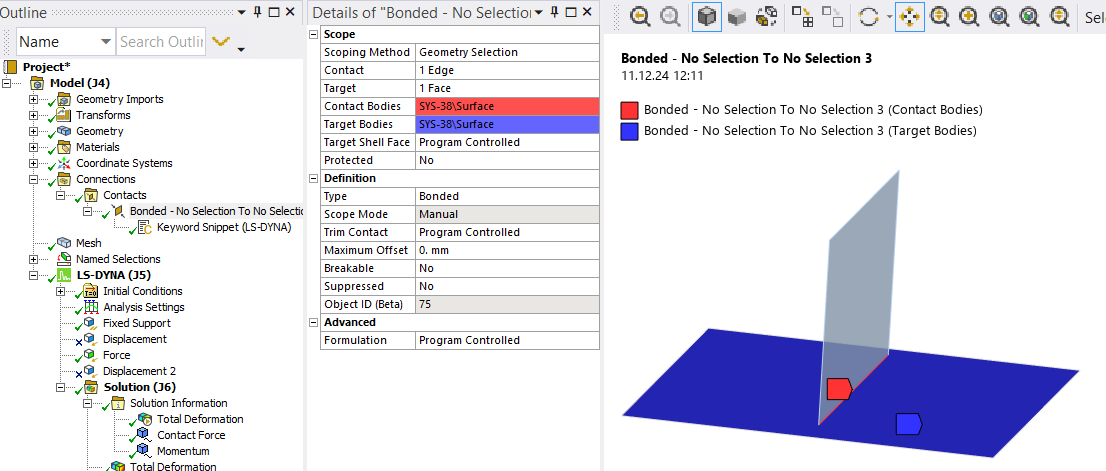TAGGED: 6-dof, bonded-contact-failure, contact
-
-
December 10, 2024 at 1:35 pm
Dmytro Fedin
SubscriberHello all,
I have T-joint of two shell parts connected by bounded contact in Workbench LS-Dyna. I need the card to overwrite the built-in settings for bounded contact to have the following:
1. Translational and rotational DOFs tied
2. Contact stress/force failure criterionNow I have:
*CONTACT_TIED_SURFACE_TO_SURFACE_FAILURE contact has stress failure criteria but doesn't tie rotational DOFs (it works for lap joint). *CONTACT_TIEBREAK_NODES_TO_SURFACE contact has force failure criteria but doesn't tie rotational DOFs as well.
I'm wondering if there is any type of contact for shell T-joint contact with 6 DOFs and failure?
-
December 10, 2024 at 3:55 pm
Nanda
Ansys EmployeeHello Dmytro,
Your options might be limited if you use contacts alone for this requirement. Can you let us know more about your application? I'm guessing this is for a weld joint, correct?
Can you consider using,*CONTACT_TIED_SHELL_EDGE_TO_SURFACE- This contact type ties both translational and rotational DOFs.
- It should also allow the implementation of failure criteria when used in conjunction with appropriate materials or modelling techniques, such as combining it with spot welds or other beam elements.
Please let us know if this didn't help.
Regards,
Nanda.
If you are not able to open Ansys help links, refer to this forum discussion: How to access the ANSYS Online Help
Also, we launched a public help documentation website: Ansys Help
For more exciting courses and certifications, hit this link: Ansys Innovation Courses | ANSYS Innovation Space
-
December 11, 2024 at 10:19 am
Dmytro Fedin
SubscriberHello Nanda,
Thanks for the quick reply. The idea is to model the glue joint using the simplest approach that allows the ultimate force/stress for the glue to be set. I can use the appropriate card to make the contact of type tied_shell_edge_to_surface:
*CONTACT_tied_shell_edge_to_surface
$ ssid msid sstyp mstyp sboxid mboxid spr mpr
3 4 0 0 0 0 1 1
$ fs fd dc vc vdc penchk bt dt
0 0 0 0 0 0 0 0
$ sfs sfm sst mst sfst sfmt fsf vsf
0 0 0 0 0 0 0 0This card works. The contact transmits translational and rotational DOFs for shell structure.
But I have no idea how to set debonding for this contact(. This setting should have the ultimate stress for the glue that is not being modeled directly.
Could you please help me find the right way to set the appropriate settings?
-
December 13, 2024 at 5:01 pm
Nanda
Ansys EmployeeHello Dmytro,
To better address your application. Here are some approaches you can consider:- Can you try adding an additional 1 row of elements as a different part to represent the glue and add a failure criteria using *MAT_ADD_DAMAGE_GISSMO? More details can be found on page 62 of Volume II: ansyshelp.ansys.com/account/secured?returnurl=/Views/Secured/corp/v242/en/lsdyna_kw_vol1/lsdyna_kw_vol1_intro.html
- Or model this T joint with solid elements and use a tiebreak contact?
- You can either model debonding with tiebreak or cohesive elements.
Hope this helps.
Best,
Nanda -
December 13, 2024 at 6:58 pm
Dmytro Fedin
SubscriberHello Nanda,
Your considerations make sense. However, due to the lack of data, the idea is to make the model as simple as possible. The layer of extra elements with *MAT_ADD_DAMAGE_GISSMO model looks perspective!
Thanks for the idea!
-
- You must be logged in to reply to this topic.



-
3492
-
1057
-
1051
-
955
-
932

© 2025 Copyright ANSYS, Inc. All rights reserved.










